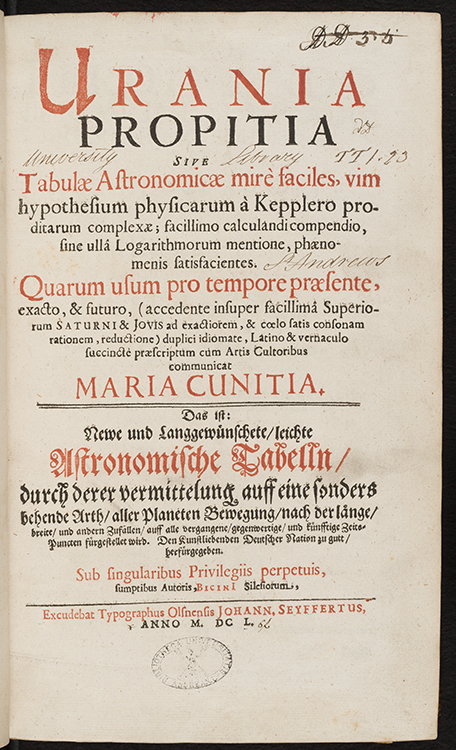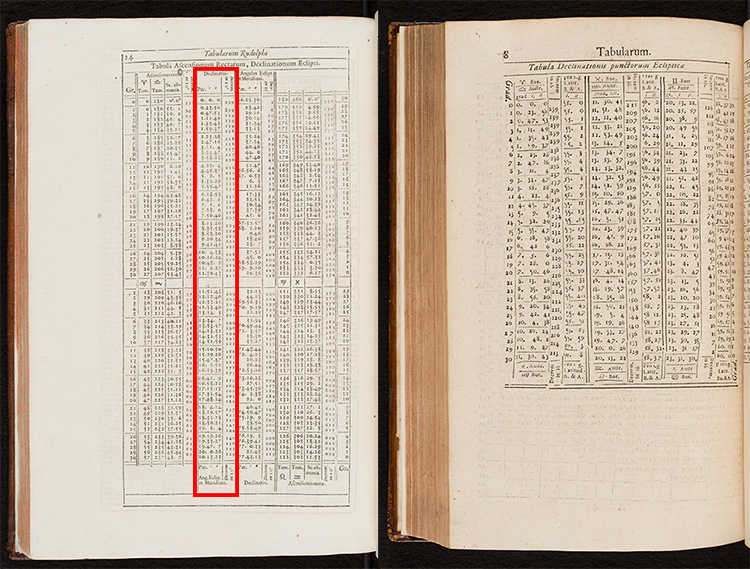Urania Propitia by Maria Cunitz
In this blog Farah Wallauer outlines a 2023 summer project which was made possible through funding from the Royal Astronomical Society and Science and Technology Facilities Council (STFC) public engagement funding, as well as the guidance of supervisors Prof Isobel Falconer and Dr Anne-Marie Weijmans.
What would you say if your GP consulted your horoscope as a diagnostic measure? What if forecasts concerning the weather, outcomes of political crises, and the future lives of your children were entrenched in the study of the night sky?
Centuries ago, looking to astrology to gain certainty about such aspects of life was a lived reality for people across all echelons of society. But while members of the aristocracy could engage personal astrologers, there was a great demand for accessibly priced, easily obtainable astrology for the less-fortunate masses. Such demand would contribute to the incredible rise in popularity of so-called ‘calendars’ (or ‘almanacs’) across Europe throughout the 1500-1600s. Calendars were small, light-weight booklets containing information like the length of night and day, appearances of eclipses, and planetary conjunctions throughout the year for a given place. Studying the way that astronomical events were calculated therein – and by whom – was the starting point for my summer project in St Andrews.
What I did not expect, however, was to stumble into the work of Maria Cunitz – an astonishing female scientist who would soon become a cornerstone of my research. Active in the 1600s, she authored a fascinating astronomical work, the Urania Propitia (published 1650), which demonstrates a practical and theoretical expertise in the astronomical context of its time that is nothing short of exceptional. The opportunity to work with University Collections’ own copy of this work was a formative part of my research as well as an amazing personal experience.
To understand the Urania Propitia and its impact, it is first important to consider the development of astronomical techniques throughout the 16th and 17th centuries generally. These techniques were applied not only by calendar-makers, but astronomers of the time and, pivotally, revolutionized by the publication of Johannes Kepler’s ‘Rudolphine Tables’ in 1627. These notably presented Kepler’s theory of planetary motion in a way that facilitated the calculation of a planet’s position at any point in the past or future (from 3993BCE to 2100CE) with unprecedented accuracy. This was due to several assumptions Kepler made in his model, including that the shape of planetary orbits was elliptical rather than circular. Although his tables were incredibly well-respected, they also required notoriously complex, tedious calculations on the reader’s part. Notably, they relied on the use of logarithms – invented only 30 years prior and not even universally understood by mathematicians of the time.
The Urania Propitia was therefore devised by Cunitz (with remarkable rapidity) expressly to alleviate these computational challenges for the reader, as stated on its title page:

In studying the methods required to work with both the Rudolphine Tables and Urania Propitia, I was able to experience firsthand the extent of Cunitz’ success. Calculations were made simpler, faster, and more intuitive. The computational effort on Cunitz’ part, by the same token, was therefore incredible in both quantity and quality, establishing her thorough understanding of Kepler’s cutting-edge theories. Moreover, her inclusion of a German explanatory text alongside the traditional, scholarly Latin was pioneering both in developing German as a scientific language and in so openly seeking to render complex scientific concepts accessible to a wider audience. An example of this can be found in corresponding sets of tables in the Urania Propitia and Rudolphine Tables, shown below (both from University Collections’ own editions!). Both tables are used to convert between different astronomical coordinate systems. Kepler’s table spans two pages, lists three corresponding variables split across five columns, and is read both from bottom to top and top to bottom, with not every column labelled intuitively. Cunitz, on the other hand, describes each corresponding variable with a separate string of tables. This simplification eliminates confusion for the reader whilst increasing the page span (and hence printing cost) to twenty-five pages.

The details of Cunitz’ own life serve only to make these feats more remarkable. With the path to university closed to her as a woman, her exceptional educational attainment was made possible by the initial sponsorship of her father and later marriage to physician and hobbyist astronomer, Elias Crätschmair. However, it is undoubtedly only through her own determination that she was able to gain not only her scientific and mathematical prowess, but proficiency in seven languages including Hebrew, Greek and Latin. Working mainly from Pitschen in Silesia (modern-day Poland), Cunitz and her husband observed together and maintained correspondences with notable contemporaries. Throughout their lives, they would be displaced by the Thirty Years’ War and faced the decimation of their home, records, and tools in a catastrophic fire in 1656.
The Urania Propitia, emerging from this maelstrom of complications, is therefore not only a remarkable achievement in and of itself, but a triumph over a complex landscape of adversity. University Collections’ own copy was likely purchased by James Gregory (notable physicist and namesake of St Andrews’ largest telescope – the largest operational optical telescope in the UK) at a time when female students were still unable to attend the university. And now, its investigation lies in the hands of a female astrophysics student at St Andrews in 2024 – where women now comprise a majority of the student body. This poignant through-line of societal development framing the journey of the Urania Propitia from Cunitz’ hands to mine – from 1650 to 2024 – was an almost awe-inspiring and motivational aspect of my research. The opportunity to handle an edition of it myself also gave me a tactile understanding of the sense-impressions a contemporary reader may have had, adding an entirely new dimension to my appreciation of the work.
Looking to the future, I hope to now raise awareness about Cunitz and the Urania Propitia not only by writing about my findings, but partially digitizing tables and coding routines to automate the subsequent calculation of planetary positions. In so doing, I hope to carry part of this remarkable work into the digital era and render it as an accessible resource for those interested in the historical development of astronomy. And, more generally, to facilitate a wider insight into the legacy of such a notable female scientist in this context.
To anybody interested and wanting to learn more about astrophysics at St Andrews, I would recommend attending the Observatory Open Night on the 9th of March this year! More details can be found at https://observatory.wp.st-andrews.ac.uk/

Wow, this is super interesting and important! It's amazing how she overcame gender biases for her contributions to astronomy.